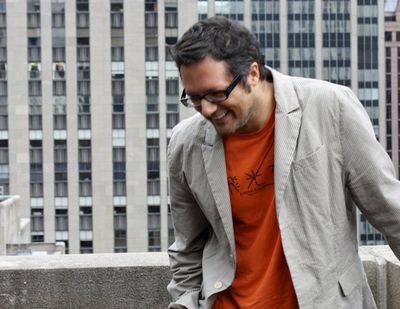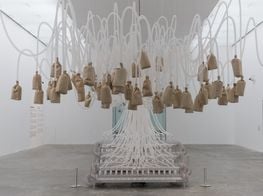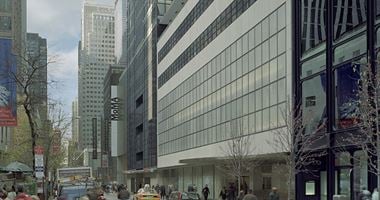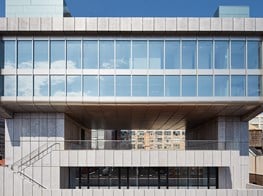Rafael Lozano-Hemmer

Rafael Lozano-Hemmer creates and develops interactive installations that are at the intersection of architecture and performance art.
His large-scale interactive installations have been commissioned for events such as the Millennium Celebrations in Mexico City (1999), the Cultural Capital of Europe in Rotterdam (2001), the UN World Summit of Cities in Lyon (2003), the opening of the YCAM Centre in Japan (2003), the Expansion of the European Union in Dublin (2004), the memorial for the Tlatelolco Student Massacre in Mexico City (2008), the 50th Anniversary of the Guggenheim Museum in New York (2009) and the Winter Olympics in Vancouver (2010).
He has received two BAFTA British Academy Awards for Interactive Art in London, a Golden Nica at the Prix Ars Electronica in Austria, "Artist of the Year" Rave Award from Wired Magazine, a Rockefeller fellowship, the Trophée des Lumières in Lyon and an International Bauhaus Award in Dessau.
OEYou studied chemistry, and although you did not pursue the sciences in your career it has influenced your work in many ways. Can you tell us about how you came to work as an artist and how you have blended these two distinct disciplines?
RLHMy parents were nightclub owners in Mexico so I grew up around salsa bands, transvestite shows, drunk artists and disco lights. After getting my degree in chemistry I worked for a few months in a corporate lab but I started hanging out with artists and musicians and we would do performance art first in a radio program and then in museums and festivals. I guess I went back to what was familiar. I am still very inspired by contemporary science, though, which I think is often way more bizarre than anything happening in art.
OEYou have said that you view your artworks as "platforms for public participation". That in a sense you are 'crowd sourcing the content'. Can you expand on this a bit and how you view your work with respect to notions of community?
RLHMany, but certainly not all, of my pieces are about self-representation. The public makes recordings which then become the content of the work itself. They "leave behind" their fingerprint, voice, heart-beat, breath or any other measure of their presence. In that sense the projects are public portraits. But I make no claims about community-building. On the contrary, I enjoy the differences and tensions that get underlined with this type of public agency.
OEDoes the fact your works rely on viewer participation mean that there is the potential for your works to be transformed by the participation into something that you didn't expect? Does improvisation occur?
RLHYes and this is very important: the work by definition needs to be out of my control. The most successful pieces always have an outcome that I did not anticipate. People tend to "personalise" the experience and thus the work is always in a state of "becoming" something, not being something predetermined.
OEOne of the ways in which your work is distinctive is through your extensive use of technology. Could you tell is about the creation of a work such as Open Air in Philadelphia in 2012, and what it involved?
RLHOpen Air was a complex work technologically but the basis of it—visualising free-speech at a time where public liberties are very much curtailed—is a straight-forward aesthetic and political agenda. The project allowed anyone in Philadelphia to control 24 bright searchlights over the Benjamin Franklin Parkway by sending voice messages using a free phone app or an internet connection (free loaner smartphones were given to anyone who did not have his or her own).
The lights' brightness, movement and position was controlled by live analysis of people's voices, their frequency, volume, intonation and so on. Tens of thousands of participants contributed to the project with everything from political messages, to poetry, yodeling, shout-outs and marriage proposals. This is all archived at www.openairphilly.net
OEWith the ever-changing technological landscape how do you ensure the integrity of your works in the future?
RLHA work like Open Air in Philadelphia is meant to be ephemeral. The technologies we used (Google Earth, JavaScript, voip codecs, zeromq scheduling, iPhones, etc) will all disappear and that is fine by us as the project is a performance. I have other lines of work, mostly acquired by museums and collectors, which are meant to be performed into the future. For those works we follow "best practices" for conservation. For example, we always give the source code to the collector.
This means that the piece is a set of instructions that can be performed at a later date in a future context: something similar to how a Sol LeWitt piece can emerge from his instructions. Recently MoMA in NYC took the Windows software that runs my installation 33 Questions per Minute and completely rewrote it for Linux. This successful "migration" from one type of computer to another is one of many examples that show how conservation of some types of media art is certainly more feasible than say conserving a photographic print.
OEAre there any new technologies under development that you are excited about working with in the future?
RLHYes, at the studio we are trying to burn things with unimaginable computerised precision.
OETell us about your influencers and inspirations?
RLHAgnes Martin, Chuck D, Luis Buñuel, and a long etcetera.
OEYou have worked in locations all over the world. Is there any location in particular you would love to work or have already worked?
RLHI would love to work on the border of the United States and Mexico. Many friends of mine have made important pieces for that context in the past 30 years and I have not had a chance yet. I have several ideas I would like to explore.
OEWhat projects do you have coming up in the rest of 2013?
RLHThe two biggest things are an interactive work for the Park Avenue Tunnel in New York City featuring 360 spotlights and 180 loudspeakers and a solo exhibition at Borusan Contemporary in Istanbul which will run concurrently with the Istanbul Biennale in September and October. —[O]













































































































































































